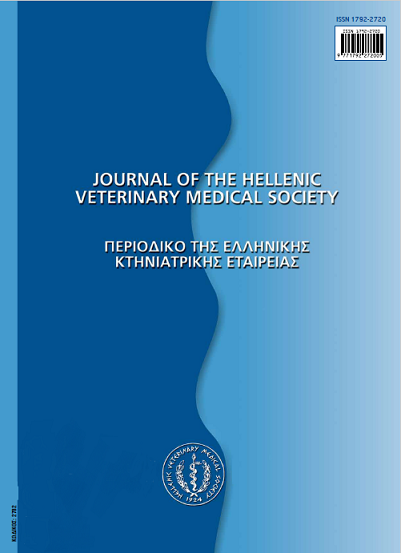A case of canine epitheliotropic lymphoma (mycosis fungoides)
Abstract
The clinical picture, diagnosis and treatment of a dog with epitheliotropic lymphoma are presented. The dog (male, mongrel, 13-year old) was admitted to our Clinic with a 5-month history of non-pruritic skin lesions. At clinical examination a multifocal to diffuse exfoliative erythrodermia was the most striking finding. Diagnosis of epitheliotropic lymphoma was based on cutaneous histopathology, revealing a dense dermal and epidermal lymphocytic infiltration and Pautrie microabcess formation. Initial treatment with isotretinoin had a poor impact on skin lesions that progressed to the macular stage. On the contrary, combination chemotherapy with Lasparaginase and isotretinoin resulted in substantial improvement. The animal died, following a short period of depression and inappetance, 15 months after the first appearance of skin lesions and 10 months after diagnosis.
Article Details
- Come citare
-
SARIDOMICHELAKIS (Μ. Ν. ΣΑΡΙΔΟΜΙΧΕΛΑΚΗΣ) M. N., KOUTINAS (X.K. ΚΟΥΤΙΝΑΣ) C. K., & KOUTINAS (Α. Φ. ΚΟΥΤΙΝΑΣ) A. F. (2018). A case of canine epitheliotropic lymphoma (mycosis fungoides). Journal of the Hellenic Veterinary Medical Society, 52(4), 286–291. https://doi.org/10.12681/jhvms.15459
- Fascicolo
- V. 52 N. 4 (2001)
- Sezione
- Case Report

Questo lavoro è fornito con la licenza Creative Commons Attribuzione - Non commerciale 4.0 Internazionale.
Authors who publish with this journal agree to the following terms:
· Authors retain copyright and grant the journal right of first publication with the work simultaneously licensed under a Creative Commons Attribution Non-Commercial License that allows others to share the work with an acknowledgement of the work's authorship and initial publication in this journal.
· Authors are able to enter into separate, additional contractual arrangements for the non-exclusive distribution of the journal's published version of the work (e.g. post it to an institutional repository or publish it in a book), with an acknowledgement of its initial publication in this journal.
· Authors are permitted and encouraged to post their work online (preferably in institutional repositories or on their website) prior to and during the submission process, as it can lead to productive exchanges, as well as earlier and greater citation of published work.












